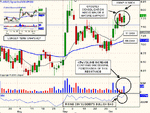How important do you consider volume in trading?
In the past I havnt paid a great amount of attention to volume when trading on tick or 1 minute charts.
Recently though I have been looking at the Dax futures entirely differently to the way I was at the start of this year.
I can now see how volume comes into play at reversals of the most recent trend.
Rather than trading breakouts I am now looking to trade the Dax on reversals, it may have a fancy name like swing trading I'm not sure.
The trick is surely to be able to distinguish between buying or selling on size.
Does anybody else use volume for trading disissions in a similar way on the Dax?
Paul
In the past I havnt paid a great amount of attention to volume when trading on tick or 1 minute charts.
Recently though I have been looking at the Dax futures entirely differently to the way I was at the start of this year.
I can now see how volume comes into play at reversals of the most recent trend.
Rather than trading breakouts I am now looking to trade the Dax on reversals, it may have a fancy name like swing trading I'm not sure.
The trick is surely to be able to distinguish between buying or selling on size.
Does anybody else use volume for trading disissions in a similar way on the Dax?
Paul
Last edited:

